Kymco Mongoose 90 User Manual
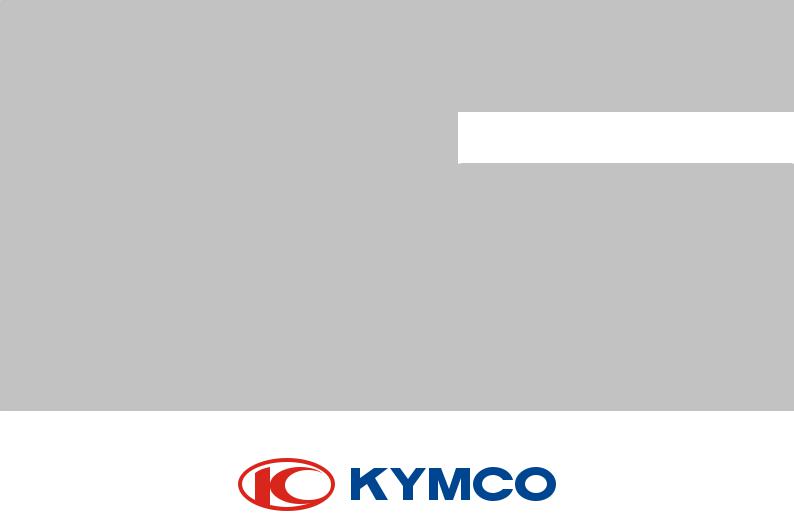
Mongoose 90 / Mongoose 90 R
ATV off road
Owner’s Manual
IMPORTANT NOTICES
READ THIS MANUAL CAREFULLY
Your Owner's Manual contains important information on safety, operation, and maintenance. Any one who operates this ATV should carefully read and
understand the contents of this manual before riding the vehicle.
It is especially important that parents make sure their children fully understand and follow the information and procedures contained in the manual.
AGE RECOMMENDATION
This ATV is intended for use by children at least 10 years old. Never allow children under the age of 10 to operate this ATV.
RIDER TRAINING
Anyone who operates this vehicle should get proper instruction.
FOR OFF-ROAD USE ONLY
This machine is designed and manufactured for OFF-ROAD use only. It is illegal and unsafe to operate this machine on any public street, road or highway.
This machine complies with all applicable OFF-ROAD noise level and spark arrester laws and regulation in effect at the time of manufacture.
Please check your local riding laws and regulations before operating this machine.
A
NOTE TO PARENTS
Parents should read the "Important Message to Parents" beginning on page 4 and the "Parents &Beginning riders" booklet received with the ATV and then decide whether their youngster is ready to ride.
"Parents, Youngsters and ATVs" focuses on the beginning rider, and discusses how to evaluate your youngster's readiness to ride as well as showing you how to introduce your youngster to ATV riding.
Your ATV was delivered with a speed restrictor for new riders. Please refer to page 7 for more information
B

SPECIAL MESSAGES
KYMCO provides many important safety messages both in this manual and on the vehicle. For your safety and the safety of others, pay special attention to all warnings preceded by this alert symbol . Failure to follow the warnings contained in this manual can result in SERIOUS INJURY or DEATH.
. Failure to follow the warnings contained in this manual can result in SERIOUS INJURY or DEATH.
|
Indicates a strong possibility that serious injury or death may |
|
WARNING |
||
result if instructions are not followed. |
||
|
To protect your vehicle from damage, pay attention to caution to cautions.
CAUTION |
Indicates a possibility that equipment or property damage |
|
could result if instructions are not followed. |
Note: |
Gives helpful information |
The Owner's Manual should be considered a permanent part of your ATV. It should remain with the vehicle at all times and stay with the ATV if it is sold.
C

PREFACE
Congratulations on your purchase of the KYMCO ATV. KYMCO take pride in a worldwide reputation for quality-in research, design, production and service.
For replacement parts and accessories, we recommend genuine KYMCO products. They've been specially designed for your vehicle and manufactured to meet KYMCO's demanding standards.
This manual will provide you with a good basic understanding of the features and operation of this machine. This manual includes important safety information. It provides information about special techniques and skills necessary to ride your machine. It also includes basic maintenance and inspection procedures. If you have any questions regarding the operation or maintenance of your machine, please consult a KYMCO dealer.
We wish you many years of safe and enjoyable riding.
While reading this manual, remember:
Indicates a strong possibility that serious injury or death may  WARNING result if instructions are not followed.
WARNING result if instructions are not followed.
All information in this publication is based on the latest product information available at the time of approval for printing. KWANG YANG MOTOR CO.,LTD reserves the right to make changes at any time without notice and without incurring any obligation.
D
CONTENTS |
|
Page |
Page |
LOCATION OF THE WARNING AND |
|
SPECIFICATION LABELS........................... |
1 |
SAFETY INFORMATION............................. |
4 |
IMPORTANT MESSAGE TO PARENTS...... |
4 |
Evaluate Riding Readiness .................... |
4 |
Always Supervise Young Riders.............. |
7 |
SPECIAL SAFETY MESSAGES........... ..... |
9 |
DESCRIPTION AND MACHINE |
|
IDENTIFICATION..................................... |
15 |
Key identification number.. .....................15 |
|
Frame and engine serial number.............. |
16 |
Model code............................................ |
16 |
Parts location........................................ |
17 |
CONTROL FUNCTIONS........... ................ |
20 |
Ignition switch...................................... . |
20 |
Handlebar switches................................ |
21 |
Engine stop switch............................... |
21 |
Headlight switch.... .............................. |
22 |
Stater button.. . ...................................22 |
|
Kick starter ............ .............................. |
23 |
Remote engine stop switch. .................... |
24 |
Throttle lever... .....................................25 |
|
Speed limiter.... ..................................... |
26 |
Front brake .......... . ............................... |
27 |
Rear brake ............................................ |
27 |
Parking brake. ......................................28 |
|
Fuel tank cap .. ...................................... |
29 |
Fuel valve . .......................................... |
30 |
Start (choke)......................................... |
31 |
Seat...................................................... |
32 |
Flag pole bracket................................... |
33 |
Storage compartment . .......................... |
33 |
(Cont'd)
E
|
Page |
PRE-OPERATION CHECKS...................... |
34 |
Front and rear brakes............................. |
35 |
Fuel ..................................................... |
36 |
Engine oil and Transmission oil ............... |
38 |
Chain ................................................... |
39 |
Throttle lever......................................... |
39 |
Fittings and fasteners............................. |
39 |
Lights ................................................... |
39 |
Switches .......................... .................... |
39 |
Tires ............................. ....................... |
40 |
How to measure tire pressure ................. |
41 |
Tire wear limit ....................................... |
42 |
OPERATION............................................ |
43 |
Starting a cold engine............................. |
43 |
Starting a warm engine........................... |
45 |
Warming up........................................... |
45 |
Engine break-in..................................... |
45 |
Parking .. .............................................. |
46 |
Parking on a slope ................................. |
47 |
Accessories .......................................... |
48 |
|
Page |
Riding Your ATV........................................ |
49 |
GETTING TO KNOW YOUR ATV........ |
......50 |
BEFORE RIDING .............................. |
50 |
RIDER PREPARATION ..................... |
50 |
RIDE WITH CARE AND GOOD |
|
JUDGEMENT......................................... |
51 |
Pre-operation checks ............................. |
52 |
Wight limits ........................................... |
53 |
Accessories .......................................... |
54 |
No Modifications .................................... |
55 |
SAFE RIDING RULES ............................. |
56 |
BE CAREFUL WHERE YOU RIDE ............. |
59 |
FOR OFF-ROAD USE ONLY .................... |
61 |
Ride Only When Visibility Is Good ............. |
61 |
During operation .................................... |
62 |
Exhaust system.................................... |
68 |
RIDING ................................................. |
69 |
BRAKING .............................................. |
71 |
TURNING YOUR ATV ............................. |
73 |
|
(Cont'd) |
F
|
Page |
SLIDING AND SKIDDING........................ |
75 |
CLIMBING UPHILL................................. |
77 |
RIDING DOWNHILL ............................... |
83 |
CROSSING A SLOPE ............................. |
85 |
RIDING OVER ROUGH TERRAIN ........... |
87 |
CROSSING THROUGH SHALLOW |
|
WATER................................................ |
88 |
PARKING ............................................ |
89 |
WHAT TO DO IF .................................. |
90 |
WHAT TO DO ...................................... |
90 |
PERIODIC MAINTENANCE AND |
|
ADJUSTMENT......................................... |
92 |
Tool kit................................................... |
92 |
PERIODIC MAINTENANCE/ |
|
LUBRICATION....................................... |
94 |
Engine oil.............................................. |
96 |
Transmission oil................................... |
100 |
Spark plug inspection............................ |
103 |
Air filter cleaning.................................. |
104 |
Valve clearance adjustment.................. |
106 |
G
|
Page |
Idle speed adjustment.. ........................107 |
|
Throttle lever adjustment...................... |
108 |
Front brake shoe inspection.................. |
109 |
Rear brake pads inspection................... |
109 |
Front brake lever free play adjustment.... |
110 |
Brake fluid inspection........................... |
112 |
Drive chain slack check......................... |
114 |
Drive chain slack adjustment................. |
114 |
Drive chain cleaning and Lubrication...... |
116 |
Cable inspection and lubrication........... |
116 |
Brake lever lubrication........................... |
117 |
Knuckle shaft and rear fork shaft |
|
Lubrication.......................................... |
117 |
Draining the V-belt compartment ........... |
117 |
Wheel removal..................................... |
118 |
Wheel installation................................. |
118 |
Battery ............................................. |
119 |
Fuse replacement................................ |
121 |
Spark arrester cleaning......................... |
123 |
Troubleshooting ............................... |
124 |
Troubleshooting chart........................ |
125 |
(Cont'd)
|
Page |
CLEANING AND STORAGE..................... |
126 |
A. Cleaning ......................................... |
126 |
B. Storage ........................................... |
128 |
SPECIFICATIONS.................................. |
130 |
NOISE REGULATION............................. |
134 |
MAINTENANCE RECORD....................... |
135 |
INDEX................................................... |
136 |
Mongoose 90 Reverse version................. |
142 |
H
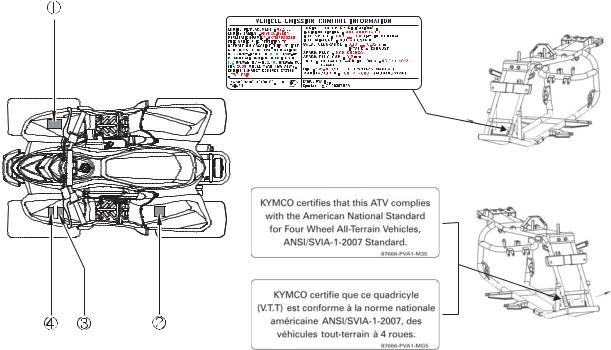
LOCATION OF THE WARNING AND
SPECIFICATION LABELS
DECAL OF EPA
CERTIFICATE LABEL OF SVIA
For US
For Canada
1
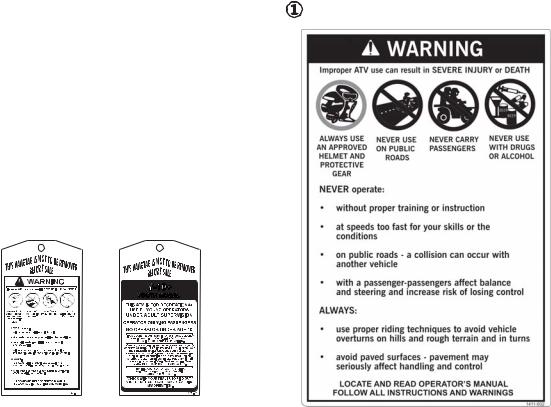
WARNING INFORMATION
Your ATV comes with a hang tag and several labels containing important safety information. Anyone who rides the vehicle should read and understand this information before riding.
Parents of young riders should make sure their youngsters read and understand the hang tag and label information before allowing them to ride.
The labels should be considered as permanent parts of the vehicle. If a label comes off or becomes hard to read, contact your KYMCO dealer for replacements
HANG TAG_GENERAL USE
Front |
Reverse side |
2
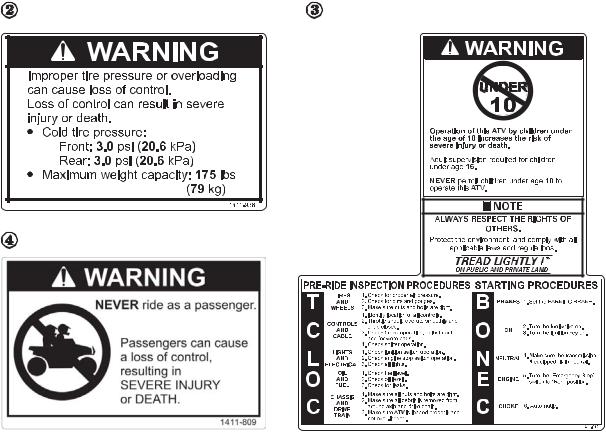
3

SAFETY INFORMATION
IMPORTANT MESSAGE TO PARENTS
Your child's safety is very important to KYMCO. That's why we urge you to read this message before you let any young person ride this ATV. Off-road riding can be fun. However, an ATV is not a toy and it can be hazardous to operate. As with any youth activity involving speed and skill-such as bicycling or skateboarding-poor judgement can result in injuries and we don't want that to happen! You can help prevent accidents by making good decisions about if, when, and how your youngster rides this ATV.
Evaluate Riding Readiness
The first decision you'll need to make is whether your youngster is ready to ride. Riding readiness varies widely from one person to another, and while the minimum age recommended for this ATV is 10 years old, there are other factors that you should consider.
4

Physical size and ability are important considerations. To help determine whether a youngster is big enough for this ATV, have them stand up on the footboards and grasp the handgrips. While the youngster holds this position, check that they have at least three inches (8cm) of clearance between the ATV seat and the youngster's "seat of the pants". A rider needs at least three inches (8cm) of clearance so they can stand up for balance and comfort, and to shift their body forward, backward and from side to side.
Also make sure your youngster can comfortably reach and work all the controls. For example, can they turn the handlebars all the way to the right and left? Can they easily use their feet to work the brake pedal and gearshift lever? Can they operate the throttle and brake levers while they hold onto the handgrips? If not, the youngster is not physically ready to ride this ATV.
Before you let a youngster ride an ATV, decide whether they are physically, mentally and emotionally ready to ride.
5
Athletic ability is another requirement for riding a ATV. Generally speaking, your youngster should be good at riding a bicycle before they get on an ATV. Can your youngster judge speeds and distances while riding a bicycle and react with proper hand and foot actions? Anyone who does not have good coordination, balance, and agility is not ready for this ATV.
Mental and emotional maturity are also necessary for safe riding. Does your youngster think through problems and come to logical solutions? On a bicycle, does your youngster obey safe riding rules? Be honest! Young people who take unnecessary risks, make bad judgments and don't obey rules are not ready to ride this ATV.
If you decide that your youngster is ready to safely operate this ATV, make sure both of you first carefully read and understand the instructions and warnings in this Owner's Manual. Also be sure that your youngster always wears a helmet and other appropriate riding equipment when operating or sitting on the ATV. (see page 55)
6
Patience And Practice
Even if a youngster takes a certified training course, it's up to you to ensure your youngster's safety. Remember, learning to ride a ATV is a gradual step-by-step process. It takes time, patience and practice.
To help you regulate your youngster's rate of learning, your ATV was delivered with an adjustable throttle limiter. We recommend that all beginning riders start off with the throttle limiter adjusted as delivered. The limiter may be adjusted to gradually increase maximum speed as the beginner becomes more familiar with operating the ATV. For adjustment and removal instructions, see pages 69
Always Supervise Young Riders
Supervision is another important obligation of parents. Even after youngsters have become skilled off-road riders, make sure they always have adult supervision while riding. It also helps to regularly remind young riders to follow the instructions and warnings in this manual. And remember, it's the parent's responsibility to see that the ATV is properly maintained and kept in safe operating condition.
If you choose to lend your ATV, do make sure that any riders under 16 years old will have adult supervision. Your youngster should understand that the decision to lend the ATV is yours.
7
In Summay
Children differ in skills, physical abilities, and judgement. Some children may not be able to operate an ATV safely. Parents should supervise their child's use of the ATV at all times. Parents should permit continued use only if they determine that the child has the ability to operate the ATV safely.
Safe and responsible riding must be an on-going commitment - by you and your youngster. When you both put safety first, you can enjoy more peace of mind, and your youngster can enjoy many hours of safe offroad riding.
8
SPECIAL SAFETY MESSAGES
AN ATV IS NOT A TOY AND CAN BE HAZARDOUS TO OPERATE. An ATV handles differently from other vehicles including motorcycles and cars. A collision can occur quickly, even during routine maneuvers such as turning and riding on hills or over obstacles, if you fail to take proper precautions.
SEVERE INJURY OR DEATH can result if you do not follow these instructions:
Read this manual and all labels carefully and follow the operating procedures described.
Never operate an ATV without proper training or instruction. Beginners should receive training from a certified instructor.
Always follow the age recommendation:
-A child under 14 years old should never operate an ATV with engine greater than 125cc.
-A child under 16 years old should never operate an ATV with engine greater than 150cc.
-A child under 10 years old should never operate this ATV.
Never allow a child under age 16 to operate an ATV without adult supervision, and never allow continued use of an ATV by a child if he or she does not have the abilities to operate it safely.
Never carry a passenger on an ATV.
Never carry cargo or tow a trailer.
9
Always avoid operating an ATV on any paved surfaces, including sidewalks, driveways, parking lots and streets.
Never operate an ATV on any public street, road or highway, even a dirt or gravel one.
Never operate an ATV without wearing an approved motorcycle helmet that fits porperly. You should also wear eye protection (goggles or face shield), gloves, boots, long-sleeved shirt or jacket, and long pants.
Never consume alcohol or drugs before or while operating this ATV.
Never operate at speeds too fast for your skills or the conditions. Always go at a speed that is proper for the terrain, visibility and operating conditions, and your experience.
Never attempt wheel, jump, or other stunt.
Always inspect your ATV each time you use it to make sure it is in safe operating condition. Always follow the inspection and maintenance procedures and schedules described in this manual.
Always keep both hands on the handlebars and both feet on the footboards of the ATV during operation.
Always go slowly and be extra careful when operating on unfamiliar terrain. Always be alert to changing terrain conditions when operating the ATV.
10
Never operate on excessively rough, slippery or loose terrain until you have learned and practiced the skills necessary to control the ATV on such terrain. Always be especially cautious on these kinds of terrain.
Always follow proper procedures for turning as described in this manual. Practice turning at low speeds before attempting to turn at faster speeds. Do not turn at excessive speed.
Never operate the ATV on hills too steep for the ATV or for your abilities. Practice on smaller hills before attempting larger hills.
Always follow proper procedures for climbing hills as described in this manual. Check the terrain carefully before you start up any hill. Never climb hills with excessively slippery or loose surfaces. Shift your weight forward. Never open the throttle suddenly. Never go over the top of a hill at high speed.
Always follow proper procedures for going down hills and for braking on hills as described in this manual. Check the terrain carefully before you start down any hill. Shift your weight backward. Never go down a hill at high speed. Avoid going down hill at an angle that would cause the vehicle to lean sharply to one side. Go straight down the hill where possible.
Always follow proper procedures for crossing the side of a hill as described in this manual. Avoid hills with excessively slippery or loose surfaces. Shift your weight to the uphill side of the ATV. Never attempt to turn the ATV around on any hill until you have mastered the turning technique described in this manual on level ground. Avoid crossing the side of a steep hill if possible.
11
Always use proper procedures if you stall or roll backwards when climbing a hill. To avoid stalling, maintain a steady speed when climbing a hill. If you stall or roll backwards, follow the special procedure for braking described in this manual. Dismount on the uphill side or to a side if pointed straight uphill. Turn the ATV around and remount, following the procedure described in this manual.
Always check for obstacles before operating in a new area. Never attempt to operate over large obstacles, such as large rocks or fallen trees. Always follow proper procedures when operating over obstacles as described in this manual.
Always be careful when skidding or sliding. Learn to safely control skidding or sliding by practicing at low speeds and on level, smooth terrain. On extremely slippery surfaces, such as ice, go slowly and be very cautious in order to reduce the chance of skidding or sliding out of control.
Never operate an ATV in fast flowing water or in water deeper than that recommended in this manual. Remember that wet brakes may have reduced stopping ability. Test your brakes after leaving water. If necessary, apply them several times to let friction dry out the linings.
Always use the size and type tires specified in this manual. Always maintain proper tire pressure as described in this manual.
Never modify an ATV through improper installation or use of accessories.
12

WARNING
POTENTIAL HAZARD
Improper handling of gasoline.
WHAT CAN HAPPEN
Gasoline can catch fire and you could be burned.
HOW TO AVOID THE HAZARD
Always turn off the engine when refueling. Do not refuel right after the engine has been running and is still very hot.
Do not spill gasoline on the engine or exhaust pipe/muffler when refueling.
Never refuel while smoking, or while in the vicinity of sparks, open flames, or other sources of ignition such as the pilot lights of water heaters and clothes dryers.
When transporting the machine in another vehicle, be sure it is kept upright and that the fuel cock is in the "OFF" position.
Otherwise, fuel may leak out of the carburetor or fuel tank.
WHAT CAN HAPPEN
Gasoline is poisonous and can cause injuries.
HOW TO AVOID THE HAZARD
If you should swallow some gasoline or inhale a lot of gasoline vapor, or get some gasoline in your eyes, see your doctor immediately.
If gasoline spills on your skin, wash with soap and water. If gasoline spills on your clothing, change your clothes.
13

ON
WARNING
POTENTIAL HAZARD
Starting or running the engine in a closed area.
WHAT CAN HAPPEN
Exhaust fumes are poisonous and may cause loss of consciousness and death within a short time.
HOW TO AVOID THE HAZARD
Always operate your machine in an area with adequate ventilation.
14

DESCRIPTION AND MACHINE IDENTIFICATION
Identification number records
Record the key identification number, frame serial number, engine serial number and model code information for assistance when order replacement parts.
KEY NO.
FRAME NO.
ENGINE NO.
MODEL CODE
Key identification number
The key identification number is stamped on the hang tag as shown in the following illustration.
(1)
(1) Key identification number
15
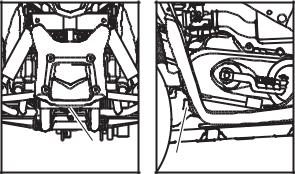
Frame and engine serial number
The frame serial number is stamped on the front of the frame.
The engine serial number is stamped on the left crankcase.
(1) |
(1) Frame serial number
(1) |
(1) Engine serial number
Model code
MODEL CODE: LA20AB
16

Parts location
(05) (04) (03) (02) (01)
(1) Handlebar switch
(2) Ignition switch
(3) Speed limiter
(4) Throttle lever
(5) Seat
17
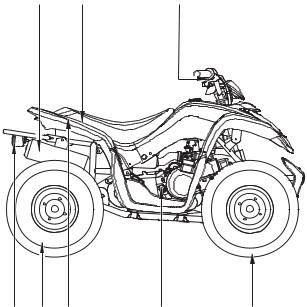
(08) |
(07) |
(06) |
(06) Remote engine stop switch
(07) Storage compartment, containing Owner's manual
Air pressure gauge Tool kit
(08) Exhaust pipe
(09) Taillight/Stop light
(10) Rear wheel
(11) Seat lock lever
(12) Oil filler cap/dipstick
(13) Front wheel
(09) (10) (11) |
(12) |
(13) |
18
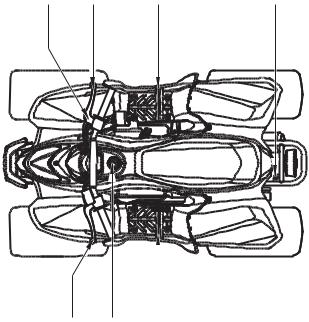
(17) |
(16) |
(15) |
(14) |
(14) Flat pole bracket
(15) Right footboard
(16) Front brake lever
(17) Parking brake
(18) Rear brake lever
(19) Fuel fill cap
(20) Left footboard
|
|
|
|
|
|
|
|
|
|
|
|
NOTE: |
|
|
|
|
|
|
|
|
|
|
|
|
|
The machine you have purchased may differ |
|
(18) |
(19) |
(20) |
|
|||
|
slightly from those shown in the figures of this |
|||||
|
|
|
|
|
||
|
|
|
|
|
manual. |
|
|
|
|
|
|
|
|
19

CONTROL FUNCTIONS
Ignition switch
Functions of the respective switch positions are as follows:
OFF:
All electrical circuits are switched off. The key
can be removed in this position. |
(1) |
ON ( ): |
|
The taillight can be turned on. |
|
With the engine stop switch at run ( |
), the |
engine can be started. |
|
The key can not be removed. |
|
OFF
 ON
ON
(2)
(1) Ignition switch |
(2) Key |
20

Handlebar switches |
|
|
(2) |
(1) |
Engine stop switch |
|
When the switch is in the RUN ( ) position, the engine will operate. When the switch is in OFF ( ) position, the engine will not operate.
|
This switch is intended primarily as a safety or |
|
emergency control, and it should normally |
(3) |
remain in the RUN ( ) position. |
|
|
|
NOTE: |
(1)Engine stop switch " " " "
"
(2)Headlight switch (for genuine KYMCO accessories)
(3)Start switch " "
If you stop your ATV by turning the engine stop switch OFF ( ), be sure to turn the ignition switch OFF to prevent battery discharge.
), be sure to turn the ignition switch OFF to prevent battery discharge.
21
